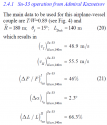You are using an out of date browser. It may not display this or other websites correctly.
You should upgrade or use an alternative browser.
You should upgrade or use an alternative browser.
J-15 carrier fighter thread
- Thread starter Jeff Head
- Start date
Brumby
Major
But still for the first time (at least since some time) the J-15D in grey ... and IMO it is clearly a J-15D and not a J-15S
View attachment 56285
What is still missing are the jamming pods. Similarly, Growlers without the ALQ-99 pods are just Super Hornets.
Any body knows what is happening with the jamming pods? I have not seen a picture of one.
Last edited:
Brumby
Major
In the video 0:58, the J15 took off from extended position of 190m in 7 seconds, achieving approximate acceleration of 8m/s² and velocity of 200 kmph off the jump.
(Su33 stall speed is about 250kmph). Since the ski jump is angled at about 14°, Horizontal V is 190kmph and Vertical V is 50kmph. Vertical V is used as a safety against sink rate until target lift is achieved.
Considering rolling resistance and drag to be nominally about 10% at lower speeds, T/W is about 0.9. If thrust is assumed to be 26 tons, then TOW is 29 tons which means its carrying a full tank of gas with 2xMraam + 2xSraam.
You are more mathematically inclined and competent than me on this subject. There is a technical paper "CARRIER SUITABILITY OF LAND-BASED AIRCRAFT" which you can google.
In that paper it goes onto a lot more mathematical calculations on the issue.


Maybe you can make more sense out of it than I can.
Brumby
Major
Those are for self protection. Dedicated jamming platforms have big size jamming pods in order to conduct standoff jamming. They require a lot of power and cooling.KG-800s (those have been seen onboard JH-7A and H-6Js) are the newest Chinese jamming pods. They should suffice for time being.
Don't get caught up in the jargon. Most of extra calculations they've done end up being nominal additions of 1-2%. Thats the reason I took a fat 10% cushion initially to absorb any unknown factors ( decrease in energy due rolling friction and drag, increase in energy due to lift and on deck wind speed).You are more mathematically inclined and competent than me on this subject. There is a technical paper "CARRIER SUITABILITY OF LAND-BASED AIRCRAFT" which you can google.
In that paper it goes onto a lot more mathematical calculations on the issue.
View attachment 56286
View attachment 56287
Maybe you can make more sense out of it than I can.
The fact that they assume T/W as 0.89, the same as i arrived at, means Mtow can be 29 tons(J15) from (140+47)m launch point as long as windspeed is 20knots.
From (68+47)m at 20kn, T/W required will be about 1.05 giving Mtow of about 24-25 tons. There will be assured dip in trajectory( depressed path) for about 3-4 seconds when launching from forward section.
Brumby
Major
Why are you assuming (140 + 47) m and not (68 + 47) m as the launch point distance? What is the end speed based on MTOW of 29 tons?Don't get caught up in the jargon. Most of extra calculations they've done end up being nominal additions of 1-2%. Thats the reason I took a fat 10% cushion initially to absorb any unknown factors ( decrease in energy due rolling friction and drag, increase in energy due to lift and on deck wind speed).
The fact that they assume T/W as 0.89, the same as i arrived at, means Mtow can be 29 tons(J15) from (140+47)m launch point as long as windspeed is 20knots.
From (68+47)m at 20kn, T/W required will be about 1.05 giving Mtow of about 24-25 tons. There will be assured dip in trajectory( depressed path) for about 3-4 seconds when launching from forward section.
I did a similar calculation years ago but drag (rolling being more of a factor than air resistance at those speeds) amounted to no more than 5%.
Big difference was thrust to weight ratio. I went with 80% of uninstalled static sl thrust, as that seems to be the average for similar planes when they actually have engines installed. As the plane goes faster, thrust slowly rises.
That would mean 245*0.8 = little under 200 kn of thrust.
Big difference was thrust to weight ratio. I went with 80% of uninstalled static sl thrust, as that seems to be the average for similar planes when they actually have engines installed. As the plane goes faster, thrust slowly rises.
That would mean 245*0.8 = little under 200 kn of thrust.
nice, but old pic - 3 numbers on the plane (102, as i spuspect)Drone view.
(1280x720)


